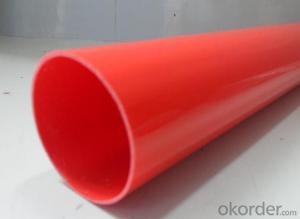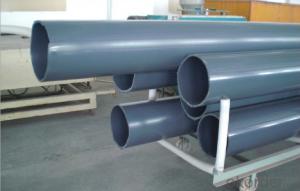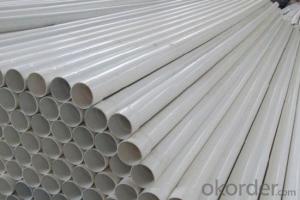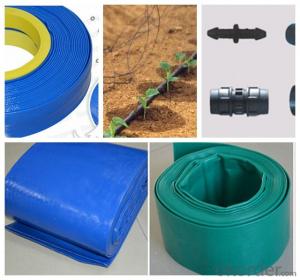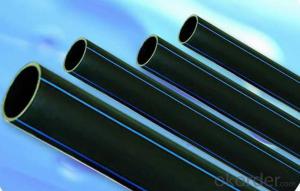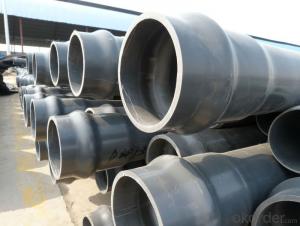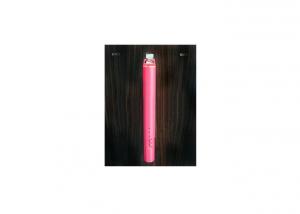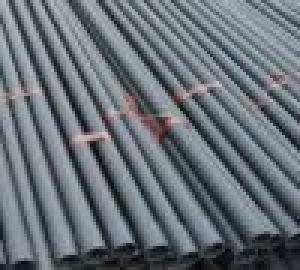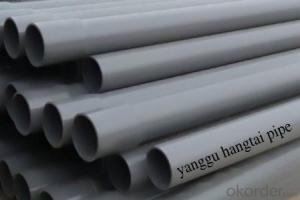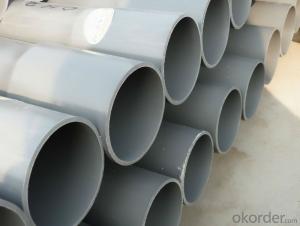Plastic Tubes HDPE Pipe ISO4427-2000 DN125
- Loading Port:
- China Main Port
- Payment Terms:
- TT OR LC
- Min Order Qty:
- -
- Supply Capability:
- -
OKorder Service Pledge
OKorder Financial Service
You Might Also Like
Physical properties[edit]
Polyethylene is a thermoplasticpolymer consisting of long hydrocarbon chains. Depending on the crystallinity and molecular weight, a melting point and glass transition may or may not be observable. The temperature at which these occur varies strongly with the type of polyethylene. For common commercial grades of medium- and high-density polyethylene the melting point is typically in the range 120 to 180 °C (248 to 356 °F). The melting point for average, commercial, low-density polyethylene is typically 105 to 115 °C (221 to 239 °F).it is transprant.
Chemical properties[edit]
Most LDPE, MDPE and HDPE grades have excellent chemical resistance, meaning that it is not attacked by strong acids or strong bases. It is also resistant to gentle oxidants and reducing agents. Polyethylene burns slowly with a blue flame having a yellow tip and gives off an odour of paraffin. The material continues burning on removal of the flame source and produces a drip.[3] Crystalline samples do not dissolve at room temperature. Polyethylene (other than cross-linked polyethylene) usually can be dissolved at elevated temperatures in aromatic hydrocarbons such as toluene or xylene, or in chlorinated solvents such as trichloroethane or trichlorobenzene.[4]
GB/T13663-2000:
| PE63管材规格 | |||||
| 公称 外径dn,mm | SDR33 | SDR26 | SDR17.6 | SDR13.6 | SDR11 |
| 公称压力 PN,Mpa | |||||
| 0.32 | 0.4 | 0.6 | 0.8 | 1.0 | |
| 公称 壁厚 | 公称 壁厚 | 公称 壁厚 | 公称 壁厚 | 公称 壁厚 | |
| 16 | 2.3 | ||||
| 20 | 2.3 | 2.3 | |||
| 25 | 2.3 | 2.3 | 2.3 | ||
| 32 | 2.3 | 2.4 | 2.9 | ||
| 40 | 2.3 | 2.3 | 3.0 | 3.7 | |
| 50 | 2.3 | 2.9 | 3.7 | 4.6 | |
| 63 | 2.3 | 2.5 | 3.6 | 4.7 | 5.8 |
| 75 | 2.3 | 2.9 | 4.3 | 5.6 | 6.8 |
| 90 | 2.8 | 3.5 | 5.1 | 6.7 | 8.2 |
| 110 | 3.4 | 4.2 | 6.3 | 8.1 | 10.0 |
| 125 | 3.9 | 4.8 | 7.1 | 9.2 | 11.4 |
| 140 | 4.3 | 5.4 | 8.0 | 10.3 | 12.7 |
| 160 | 4.9 | 6.2 | 9.1 | 11.8 | 14.6 |
| 180 | 5.5 | 6.9 | 10.2 | 13.3 | 16.4 |
| 200 | 6.2 | 7.7 | 11.4 | 14.7 | 18.2 |
| 225 | 6.9 | 8.6 | 12.8 | 16.6 | 20.5 |
| 250 | 7.7 | 9.6 | 14.2 | 18.4 | 22.7 |
| 280 | 8.6 | 10.7 | 15.9 | 20.6 | 25.4 |
| 315 | 9.7 | 12.1 | 17.9 | 23.2 | 28.6 |
| 355 | 10.9 | 13.6 | 20.1 | 26.1 | 32.2 |
| 400 | 12.3 | 15.3 | 22.7 | 29.4 | 36.3 |
| 450 | 13.8 | 17.2 | 25.5 | 33.1 | 40.9 |
| 500 | 15.3 | 19.1 | 28.3 | 36.8 | 45.4 |
| 560 | 17.2 | 21.4 | 31.7 | 41.2 | 50.8 |
| 630 | 19.3 | 24.1 | 35.7 | 46.3 | 57.2 |
- Q: Can plastic tubes be used for air conditioning systems?
- Yes, plastic tubes can be used for air conditioning systems. They are commonly used as a cost-effective and lightweight alternative to traditional metal tubes. Plastic tubes are durable, resistant to corrosion, and provide excellent insulation properties for efficient air conditioning.
- Q: How are plastic tubes tested for quality and safety?
- Plastic tubes are tested for quality and safety through a series of rigorous evaluations. These evaluations typically include tests for physical properties such as tensile strength, flexibility, and durability. Additionally, they undergo assessments for chemical and biological safety, ensuring that they are free from harmful substances and do not pose any health risks. These tests can involve conducting chemical analyses, assessing stability under various temperature and pressure conditions, and examining the tubes for potential leaching or degradation. Overall, these comprehensive testing procedures ensure that plastic tubes meet industry standards and are safe for their intended use.
- Q: What's the difference between the FPC tube and the PVC tube?
- PVC material is a kind of plastic decoration material. PVC is the abbreviation of PVC material, PVC resin as the main raw material, adding a proper amount of anti-aging agent, modifier, etc., by mixing, calendering, vacuum plastic forming process and other materials.
- Q: Okay this is a really horrifying scenario and I'm panicking. I have two 6 weeks old baby alexandarine parrots. I feed them by hand through a syringe. I attach a small rubber tube at the end of the syringe and feed them slowly. However as I was just feeding one, the tube got loose and is now stuck in the parrot's throat. I'm very worried. I can't go to a vet as there is no avian vet in our area. What should I do? Please Please help!! I'll be really thankful.
- Go to a regular vet. Though they are not bird-specific, it is still a better chance than trying to remove it yourself and risk damaging their esophagus. Hopefully it's not too late. Please at least call a vet; if you can't go to them, it's possible they can at least tell you how to safely remove the tube.
- Q: Can plastic tubes be used for packaging chemicals?
- Yes, plastic tubes can be used for packaging chemicals.
- Q: Are plastic tubes suitable for electrical conduit?
- No, plastic tubes are not suitable for electrical conduit as they lack the necessary fire resistance and durability required for electrical wiring systems.
- Q: What are the advantages of using plastic tubes in the cosmetics industry?
- There are several advantages of using plastic tubes in the cosmetics industry. Firstly, plastic tubes are lightweight and portable, making them convenient for travel and on-the-go use. Secondly, plastic tubes provide excellent product protection, preventing contamination and preserving the quality and shelf life of cosmetics. Additionally, plastic tubes are cost-effective, allowing for affordable packaging options, especially for smaller cosmetic brands. Lastly, plastic tubes are versatile and can be easily customized with various colors, shapes, and sizes, enhancing product aesthetics and branding.
- Q: Can plastic tubes be used for promotional packaging?
- Yes, plastic tubes can be used for promotional packaging. They provide a convenient and attractive way to package and display products, allowing for customization with branding and messaging. Plastic tubes are lightweight, durable, and versatile, making them a popular choice for promotional packaging in various industries.
- Q: What are the advantages of using plastic tubes in the medical industry?
- There are several advantages of using plastic tubes in the medical industry. Firstly, plastic tubes are lightweight and flexible, making them easy to handle and maneuver during medical procedures. Secondly, plastic tubes are transparent, allowing healthcare professionals to monitor fluid flow and detect any blockages or irregularities. Additionally, plastic tubes are biocompatible, meaning they are unlikely to cause any adverse reactions or infections in patients. Lastly, plastic tubes are cost-effective compared to other materials, making them a more affordable option for medical facilities.
- Q: I have a tube thats plastic and after i peeled the sticker off it was all sticky. Any help?
- Old fashioned liquid cigarette lighter fluid will dissolve the adhesive and you can wipe it off with a soft cloth or paper towel.
Send your message to us
Plastic Tubes HDPE Pipe ISO4427-2000 DN125
- Loading Port:
- China Main Port
- Payment Terms:
- TT OR LC
- Min Order Qty:
- -
- Supply Capability:
- -
OKorder Service Pledge
OKorder Financial Service
Similar products
Hot products
Hot Searches
Related keywords





